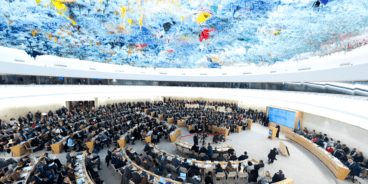
When Nations Kill Their Own
The article below was written by Chair of the Global Centre’s International Advisory Board, Prof. the Hon. Gareth Evans published in The Christian Science Monitor regarding the need to continue developing the principle of the Responsibility to Protect, particularly in the case of Myanmar (Burma).
At the height of the bloody suppression by the Burma (Myanmar) regime of protesting monks last year, the heated question was whether the international community should intervene. In response, a well-known Chinese professor told an American newspaper “China has used tanks to kill people on Tiananmen Square. It is Myanmar’s sovereign right to kill their own people, too.”
That is about as chilling and abhorrent a statement as it gets for many in developed countries. It’s an apparent apologia not only for Tiananmen and the October crackdown, but the killing fields of Cambodia, the genocide in Rwanda, the bloody massacre of Srebrenica, and the crimes against humanity continuing in Darfur.
The statement reflects a feeling that seems to ignore the developments in international human rights law since 1945 – from the Universal Declaration and the Covenants, to the Genocide Convention and the Rome Statute establishing the International Criminal Court. And it seems to embrace the starkest possible interpretation of Westphalian principles; not only that what happens within state borders is nobody else’s business, but that sovereignty is a license to kill.
For many others, however, the Chinese professor’s statement, while probably chilling in its directness, and certainly less diplomatically expressed than it could have been, captures a sentiment that has great resonance in the developing world. It’s also one that has too often been ignored by enthusiastic human rights campaigners arguing for “the right to intervene,” by coercive military force if necessary, in internal situations.
While the right of humanitarian intervention might be seen in most of the developed world as a noble and effective rallying cry, it had the capacity elsewhere to enrage. And it continues to do so, not least among those new states emerging from the post World War II period, proud of their identity, conscious in many cases of their fragility.
To try to resolve this tension between competing worldviews, the concept of “the responsibility to protect,” or R2P, was devised as a new rallying cry to replace the call for “the right to intervene.”
The core of R2P is that sovereign states should retain the primary responsibility to protect their own people from mass atrocities. But if they manifestly fail to do so, through either incapacity or ill will, then it becomes the collective responsibility of the international community to take appropriate action. Sovereignty conveys no immunity when massive human rights violations are involved. The emphasis is on prevention and assistance for states in need. And any further response necessary stresses using the least coercive and intrusive effective means possible. Force might be needed, but only in extreme and exceptional cases, and with Security Council approval.
The R2P concept was proposed by a Canadian-sponsored international commission in 2001, and it took only four years – just a blink of an eye in the history of ideas – for the principles to be adopted, without dissent, by the UN General Assembly.
But celebration remains premature: It is one thing to have a new norm of international behavior up in lights, quite another (as the Chinese professor’s comment shows) for it to be genuinely universally accepted, and yet another thing for it to be effectively applied.
The international community’s immediate response – and by diplomatic rather than military means – to the postelection explosion of ethnic violence in Kenya at the beginning of this year was an excellent example of the new norm. And it provides very stark contrast to the cynicism and indifference that greeted the Rwandan genocide in 1994.
But other cases, like the Burma cyclone and the Russian invasion of Georgia, have been either prematurely labeled or mislabeled as R2P ones. And while Darfur is properly labeled a case of acute R2P concern, it is one where the international response has so far been very ineffective.
Three big challenges remain for like-minded governments and civil society organizations who understand and accept the power of the R2P norm:
First there is the conceptual one of ensuring that its scope and limits are fully understood, so that it is not seen as either too broad to be useful or too narrowly militarily focused to be acceptable. Second, there is the institutional one, of ensuring diplomatic, civilian, and military capacity is available to respond effectively to new situations.
And last, there is the political one of ensuring that, when preventive or reactive action becomes necessary, the will is there to mobilize that capacity.
If we are never again to have to say “never again,” these challenges simply have to be met.
Gareth Evans, former Australian foreign minister, is president of the Crisis Group and author of “The Responsibility to Protect: Ending Mass Atrocity Crimes Once and for All.”
Related Content


Atrocity Alert No. 428: Israel and the Occupied Palestinian Territory, Myanmar (Burma) and Ukraine
